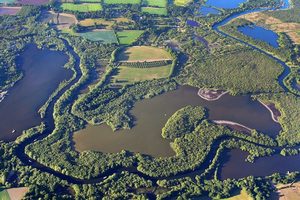Ambitious project to reverse decades of pollution in Norfolk broad
A project breathing new life in to one of Norfolk’s famous broads is to proceed to its next phase, Natural England has announced.

The Hoveton Great Broad Restoration Project has had the green light to proceed with installing underwater, permeable barriers by the Environment Agency.
These barriers will enable a process called ‘bio-manipulation’ to transform Hoveton Great Broad into a pristine, species-rich, wildlife haven.
Bio-manipulation is the second phase of the project, with phase 1 having removed around 55,000 cubic metres of sediment, which was choking the broad.
Creating a wildlife haven
The project used the sediment to create new wildlife areas and will now be carrying out bio-manipulation, which is needed to improve the water quality.
The broad currently suffers from the legacy of pollution dating back to around 1960. As a result, it is dominated by damaging algae, which stops light reaching the bed of the broad, and prevents aquatic plants from growing.
The efforts of Natural England, the Environment Agency, water companies and farmers have seen improvements in sewage treatment and farming practices. This has improved water quality to a point, but needs further action through bio-manipulation to give nature a chance to heal Hoveton Great Broad.
Helping nature recover
Bio-manipulation adds or removes certain species from an ecosystem to bring about a positive change. This tried and tested technique has been used successfully across the broads and the world.
Around 75% of fish will be moved from Hoveton Great Broad and the connected Hudson’s Bay, into a temporary new home in the wider broads system.
With the fish removed, the number of water fleas will increase and they will, in turn, eat the algae. Over time, this will lead to crystal clear water, returning light to the bed of the broad once more. This will allow a wide variety of water plants to grow again.
These new water plants will help stabilize the broad by absorbing nutrients and providing habitat and food for a more diverse wildlife community to re-establish. That includes more varied and resilient populations of fish.
Permeable bio-manipulation barriers will be sensitively installed to prevent fish re-entering the lake while the recovery takes effect. Once recovery has stabilised, the fish will be let back in.
Reversing decades of pollution
The barriers required a permit from the Environment Agency, which was granted on 14 October, following extensive research and consultation.
Watch on YouTube: How the project will restore Hoveton Great Broad
The Hoveton Great Broad Restoration Project will now work with the Environment Agency to meet the conditions of the permit. Before a date can be set for the barriers’ installation.
Restoration will be closely monitored by the project and Natural England, working with the Environment Agency and in liaison with Bournemouth University as part of PhD research.
An advisory group of interested parties will be set up to ensure the project benefits from local knowledge of river systems and fisheries management. It will be one of the most significant fish monitoring programmes ever conducted in the broads.
Hannah Thacker, Natural England’s area manager for Norfolk and Suffolk, said:
This exciting nature recovery project will reverse the impact of decades of pollution. This will help to re-establish the broad’s once great ecological quality, all using proven restoration techniques.
The resulting biodiversity will be more resilient to the effects of climate change and secure the future of this important wetland habitat. This is not only for nature’s benefit but for everyone who enjoys this unique place.
The Norfolk broads are a unique landscape of lakes and rivers covering more than 300 square kilometres.
Hoveton Great Broad is one of the largest of these lakes. It is a key part of an internationally important, man-made wetland landscape, supporting more than 11,000 species. This includes 31 that are found almost exclusively here, and attracting 8 million visitors a year.
Internationally important landscape
Historic pollution from a growing population and booming agricultural industry has left its mark. Since the 1960s, Hoveton Great Broad has deteriorated to its current ‘unfavourable’ state, and would not fully recover without support.
The Hoveton Great Broad Restoration Project provides that support.
The efforts of Natural England, the Environment Agency and water companies have seen progress in sewage treatment and farming practices. As a result, water quality has now improved to a point where bio-manipulation can return the broad back to favourable conditions – and restore it to its former glory.
The Hoveton Great Broad Restoration Project is supported by the European Union LIFE+ Nature and Biodiversity Programme, Natura 2000, and the National Lottery Heritage Fund.
Visit the project’s website for more information about the work, the broad, and visiting the area’s nature trail.